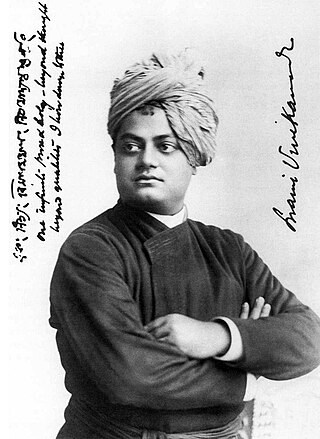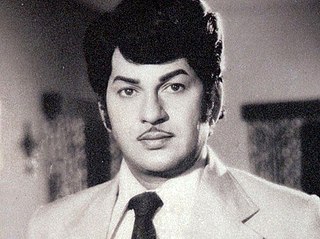Mrunalini Desai was a Marathi writer [1] from Maharashtra, India.
Mrunalini Desai was a Marathi writer [1] from Maharashtra, India.
The following is a list of her books:

Ramakrishna Math and Ramakrishna Mission (RKM) is a spiritual and philanthropic organisation headquartered in Belur Math, West Bengal. The mission is named after the Indian Hindu spiritual guru and mystic Ramakrishna. The mission was founded by Ramakrishna's chief disciple Swami Vivekananda on 1 May 1897. The organisation mainly propagates the Hindu philosophy of Vedanta–Advaita Vedanta and four yogic ideals – Jnana, Bhakti, Karma, and Raja yoga. The mission bases its work on the principles of Karma Yoga, the principle of selfless work done with a dedication to God.
The Divine Light Mission was an organization founded in 1960 by guru Hans Ji Maharaj for his following in northern India. During the 1970s, the DLM gained prominence in the West under the leadership of his fourth and youngest son. Some scholars noted the influence of the Bhagavad Gita and the Radha Soami tradition, a.k.a. Sant Mat movement, but the western movement was widely seen as a new religious movement, a cult, a charismatic religious sect or an alternative religion. DLM officials said the movement represented a church rather than a religion.

Ramakrishna Math is the administrative legal organization of the Ramakrishna Order, of Daśanāmi Sampradaya. It was set up by sanyasin disciples of Ramakrishna Paramhansa headed by Swami Vivekananda at Baranagar Math in Baranagar, a place near Calcutta, in 1886. India. The headquarters of Ramakrishna Math and its twin organisation, Ramakrishna Mission is at Belur Math.
M. P. Pandit was a spiritual author, teacher and Sanskrit scholar. For several decades, he was a secretary of the Mother of the Sri Aurobindo Ashram. He wrote numerous books and articles on the yoga of Sri Aurobindo and the Mother, on social and political thought, science, philosophy, religion, mysticism, and the classical texts and spiritual traditions of India.

P. Parameswaran, often referred to as Parameswarji, was a Rashtriya Swayamsevak Sangh (RSS) pracharak from Kerala, India who was erstwhile Vice‑President of the Jan Sangh.
Swamiji is a 2012 laser show and documentary film directed and produced by Manick Sorcar. Based on the life story of Hindu monk Swami Vivekananda (1863–1902), it is the first laser documentary made on an individual and the first full-length laser documentary ever to be shown in a performing arts center.
Thirumazhisai is a western suburb of Chennai, India. It is located in Thiruvallur district of Tamil Nadu. Located on the way to Thiruvallur, the neighbourhood is situated at a distance of 28 km from the city's kilometer zero. The nearest railway station is at Thiruninravur, which is 13 km away.

Vedanta Societies refer to organizations, groups, or societies formed for the study, practice, and propagation of Vedanta, the culmination of Vedas. More specifically, they "comprise the American arm of the Indian Ramakrishna movement" and refer to branches of the Ramakrishna Order located outside India.

Kachinamthoduka Puthiyapurayil Ummer known as K. P. Ummer was an Indian actor from Thekkepuram quarter of Kozhikode, Kerala, India. He was active in the Malayalam cinema from the early sixties until the late nineties.

Vijaya Bhaskar was an Indian music director and composer who composed music for several mainstream and experimental feature films in the Kannada film industry. Scoring music for over 720 films, Bhaskar worked in Tamil, Telugu, Malayalam, Marathi, Tulu and Konkani language films as well. He was a part of all films of director KSL Swamy (Ravi) and also shared a great association with acclaimed directors Puttanna Kanagal and Adoor Gopalakrishnan.
Karaganahalli Subbaraya Ashwathanarayana was an Indian veteran actor who appeared in Kannada films. He appeared in over 370 films during his five-decade-long career. His only memorial in the whole of Karnataka, India is in the Kengeri satellite town, Bengaluru. Memorial name - "K. S. Ashwath Memorial Children's Park".

K. V. Raghunatha Reddy was an Indian politician. He served three terms as Member of Rajya Sabha from Andhra Pradesh during the period 1962-68, 1968–74 and 1974-1980. He served as the Governor of Tripura (1990–1993), the Governor of West Bengal (1993–1998) and the Governor of Odisha. He also worked as union labour minister.

The Ramakrishna Mission Institute of Culture (RMIC) in Kolkata, India, is a branch of the Ramakrishna Mission founded on 29 January 1938 as an outcome of the commemoration of Sri Ramakrishna's Birth Centenary Celebrations, the institute has grown over the years, and is now situated on its present magnificent premises at Gol Park in Kolkata.
Eugene Petrovich Chelyshev or E. P. Chelyshev was a Russian Indologist, academician and public figure. He was a full-time member of the Russian Academy of Sciences (1987), and he was the Academician-Secretary of the Department of Literature and Language Sciences (1988–2002), and a member of the Presidium of the Russian Academy of Sciences. He was awarded two Orders of the Red Star, Order of the Patriotic War II degree (1985), Order "For Merit to the Fatherland" IV Degree (1997), III degree (2007), II degree (2020), Order of Honour (2012). Member of the Writers' Union of Russia.

The Swami Vivekananda statue is a bronze statue of the Hindu Indian monk Swami Vivekananda (1863–1902), located in Golpark neighbourhood in the Indian city of Kolkata. The original statue, made of marble and unveiled in 1966, was the oldest statue of Swami Vivekananda in the city. The old statue was replaced by a new, taller one in 2005.
Sankari Prasad Basu was an Indian scholar, writer and critic who writes mainly in the Bengali language. He is a researcher on Swami Vivekananda and his books on the subject include Sahashya Vivekananda and Bandhu Vivekananda. One of his notable publications is his seven-volume research work Vivekananda o Samakalin Bharatbarsha, for which he won the prestigious Sahitya Akademi Award in 1978.
Belgharia High School is one of the oldest schools in Belgharia suburb of Kolkata, founded in 1872.

Ramakrishna was an Indian actor who worked in Telugu cinema. He has acted in over 200 films, including Telugu, Tamil, and Malayalam. He has acted in several super hit Telugu movies such as 'Nomu', 'Pooja', 'Nenu Naa Desam', 'Bomma Borusa', 'Badi panthulu', 'Kurukshetram', 'Yuvataram kadilindi', 'Mantralaya Sri Raghavendra Vaaibhavam', 'Hantakulostunnaru jagrattha', 'Magadu', 'Katakatala Rudraiah', 'Doralu Dongalu', 'Kotalo paga', 'Viswanatha Nayakudu'. He played various roles in several mythological films, including Yashoda Krishna, Vinayaka Vijayamu, "Sri Krishnavatharam", Devude digivasthe. He had also acted alongside thespians N. T. Ramarao and Akkineni Nageswara Rao. His contemporary Heroes were, Krishna, Haranath, and Sobhan Babu.

Jagdish Ramkrishna Joshi was a Gujarati poet and translator from India. He received a posthumous Sahitya Akademi Award in 1979 for his collection of poems, Vamal Na Van.